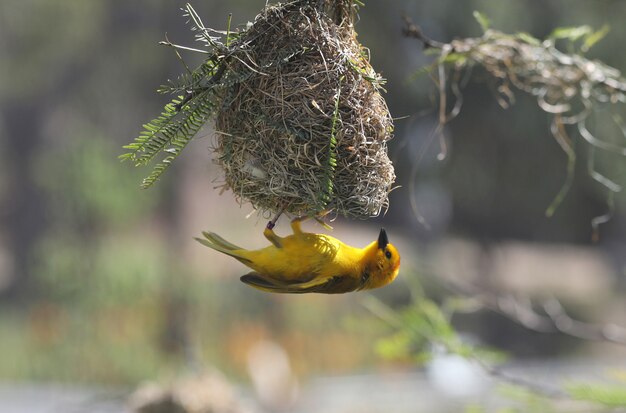Alabama is a state known for its natural beauty and diverse wildlife. Among the many bird species that call this southern state home, a striking group of birds stand out due to their vibrant yellow plumage. This article will explore some of the most notable yellow birds in Alabama, their characteristics, and their significance in the local ecosystem.
Table of Contents
ToggleThe Yellow Warbler
The Yellow Warbler, scientifically known as Setophaga petechia, is a small, vibrant bird with bright yellow plumage and a sweet, melodious song. It is a common summer resident in Alabama, where it breeds and raises its young. These tiny birds can often be spotted near wetlands, streams, and gardens, where they build their nests in shrubs and trees. They primarily feed on insects, making them essential for pest control.
The American Goldfinch
The American Goldfinch, Spinus tristis, is another bright yellow bird in Alabama. Often referred to as the Eastern Goldfinch or Wild Canary, these birds are known for their cheerful songs and preference for open fields and gardens. They primarily feed on seeds, making them frequent visitors to state bird feeders. The American Goldfinch is also the state bird of Iowa.
The Yellow-Bellied Sapsucker
The Yellow-Bellied Sapsucker, Sphyrapicus varius, is a unique woodpecker species with a striking appearance. These birds have a combination of yellow and black plumage and are known for drilling small holes in trees to feed on sap. Alabama’s forests provide an ideal habitat for these sapsuckers, where they create “sap wells” and attract insects with their sugary meals.
Yellow-Throated Warbler
The Yellow-Throated Warbler, Setophaga dominica, is a small bird with yellow plumage and a distinctive black throat. They are often found in mature forests and cypress swamps, where they forage for insects and spiders. These singers are known for their clear, whistling songs that echo through the trees in Alabama’s woodlands.
Yellow-Rumped Warbler
The Yellow-Rumped Warbler, Setophaga coronata, is another warbler species commonly found in Alabama. They get their name from the yellow patches on their rumps. These birds are incredibly adaptable and can be seen in various habitats, from forests to coastal areas. They play a vital role in controlling insect populations, especially during migrations.
Yellow-Breasted Chat
The Yellow-Breasted Chat, Icteria virens, is a striking bird with bright yellow plumage and a white “mustache”. These birds are known for their distinctive, loud, and varied songs. They prefer dense shrubbery and thickets, making them a challenge to spot. However, their vocal performances make them easily recognizable to bird enthusiasts in Alabama.
Eastern Meadowlark
The Eastern Meadowlark, Sturnella magna, is a ground-dwelling bird with a bright yellow chest and a melodic song. They are commonly found in open fields and grasslands across Alabama. Eastern Meadowlarks primarily feed on insects and seeds, contributing to the balance of the local ecosystem.
Yellow Warbler Migration Patterns
Many of these yellow birds are migratory, traveling to and from Alabama during different seasons. The timing of their migration varies, but they are generally more prominent in the state during the spring and summer months when they breed and raise their young.
Yellow Birds’ Significance in Alabama
Yellow birds are a visual delight for birdwatchers and play essential roles in Alabama’s ecosystem. They help control insect populations, disperse seeds, and contribute to the state’s biodiversity. Observing these birds in their natural habitat can be a rewarding experience for nature enthusiasts.
Conservation Efforts for Yellow Birds
Conservation efforts are crucial to ensuring the survival of these beautiful yellow birds. Protecting their habitats, reducing pesticide use, and supporting bird-friendly landscaping can all contribute to their well-being. Alabama residents and visitors can also participate in citizen science initiatives to monitor and protect these species.
Birdwatching in Alabama
Alabama offers excellent opportunities for birdwatching. The state’s diverse landscapes are home to a wide range of bird species, from its coastal areas to its forests and wetlands. Birdwatchers can explore various birding hotspots and even participate in organized birdwatching tours.
Conclusion
In Alabama, the presence of yellow birds adds a bright and musical dimension to the state’s natural beauty. These birds are visually captivating and play essential roles in the local ecosystem. By appreciating and protecting these species, we can ensure that their vibrant colors and songs continue to grace Alabama’s landscapes.
FAQs
- What is the significance of yellow birds in Alabama?
Yellow birds control insect populations and contribute to the state’s biodiversity.
- Are yellow birds in Alabama endangered?
Some species of yellow birds may face threats, but conservation efforts are in place to protect them.
- Where is the best place for birdwatching in Alabama?
Alabama offers diverse birdwatching opportunities, with coastal areas, forests, and wetlands being popular spots.
- How can I get involved in bird conservation in Alabama?
You can join citizen science initiatives, support bird-friendly landscaping, and participate in local conservation organizations.
- Are yellow birds in Alabama migratory?
Many yellow bird species in Alabama are migratory, with varying yearly migration patterns.





